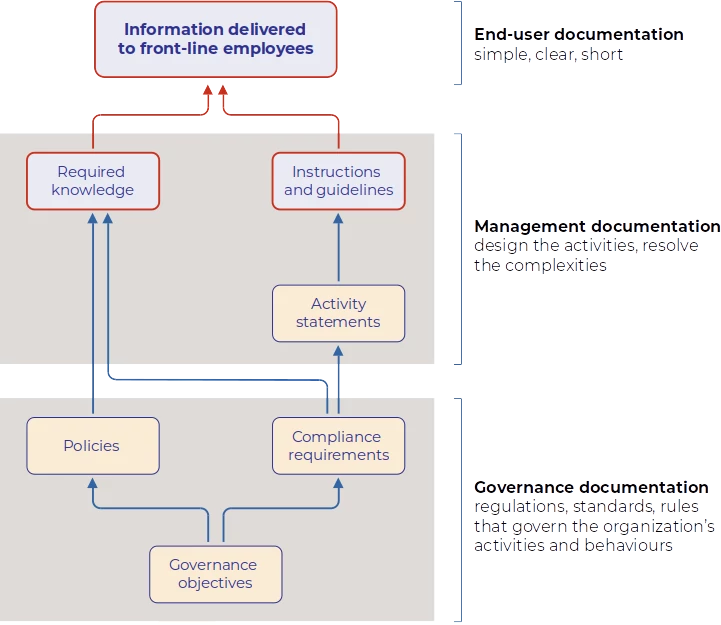Most organizations have awful documentation. There is a solution to this problem: use Phrontex to create documentation that works.
Documentation is not optional. It’s a management necessity, a legal obligation under many regulatory requirements, and an audit requirement for most ISO standards. But documentation has no value unless you can prove that a) it says the right things, and b) the right people have read it.
Most corporate documentation fails on both points.
Documentation is the system for providing personnel with the information they need so the organization functions as its managers intend that is should.
‘Creating documentation’ is not about creating documents. Documentation is about knowledge: defining it and communicating it. Creating documentation means these tasks:
Trying to manage these tasks with a collection of discrete documents obviously doesn’t work. Most organizations end up with documentation that is verbose, repetitive, hard-to-follow, inconsistent, and unreliable. It’s not surprising that no-one reads it.
“Lots of documents” does not mean well-documented.
Video
Documents are a poor way to create documentation. See the Phrontex alternative.
YouTube: 4:09
Usage subject to YouTube’s Terms of use and Privacy policy.
Phrontex manages your documentation as knowledge, not as documents: it creates an easily-managed, single source of truth about how your organization operates. It delivers a much better result, with much less effort.

Governance failure is a significant and increasing risk.
Phrontex reduces the risk of governance failure and strengthens the organization’s ability to prove that it is aware of its obligations and is doing everything it should to meet them. Phrontex provides:
Compliance and performance should be two sides of a coin, not opposite sides of a contest. To be effective and valuable, compliance should be inherent, built in to the way the organization operates. A front-line employee carrying out a procedure shouldn’t be thinking of safety or legality as something distinct from the activity itself: they should be confident that if they follow the procedure as documented, their activities will be safe and legal and consistent with policy.
It’s the manager’s responsibility to design and document their activities to be compliant: they need to be confident that they are able to do that.
Phrontex makes the connections between policies, compliance requirements, and activities, with accountabilities and responsibilities assigned and tracked.
Although it’s usually not measured, organizations have a huge investment in their corporate knowledge: a lot of management hours are expended, year on year, to create and maintain documentation. That expenditure of time should be creating and adding value to a major asset.
Traditional documentation — a library of Word documents and PDFs — depreciates quickly. The document is issued, goes out of date, and is abandoned.
By contrast, corporate knowledge in a Phrontex system gains value over time because the changes and improvements are cumulative. All work carried out on a Phrontex system is building a single body of knowledge.
As a general proposition, people want to do good work. They want to make improvements. Front-line employees are often the people best placed to understand why things go wrong and to suggest ways to solve the problem.
Phrontex facilitates the improvement cycle. Users can post comments and suggest improvements to any content, with automatic notification to the accountable manager and other interested parties.
Apart from being good management practice, in some jurisdictions the ability for employees to provide feedback is a legal requirement for anything that touches on safety.
When it comes to the management chores of creating, updating, and distributing documentation: Phrontex is quicker. Because the content is in small, discrete units, managers can make single-point updates without needing to edit and reformat entire documents.
Phrontex is a better and more economical way of doing something that the organization has to do anyway.
Converting traditional documentation to Phrontex typically delivers a 65 percent reduction in the total number of pages, with no loss of content. This delivers a corresponding reduction in other work:
Phrontex is explicit about accountabilities and responsibilities, and it encourages managers to define the boundaries and hand-offs between their respective activities. Phrontex doesn’t resolve the management disputes, of course; but it brings them to the surface.
Real example: the CEO instructed the management team members each to prepare
a single page in Phrontex setting out their management philosophy
and what they saw as their three key responsibilities. Over the
next few months each manager presented their page to the team.
In every case the list of key responsibilities turned out to be contentious.
Other team members disputed the respective boundaries of their
areas of responsibility.